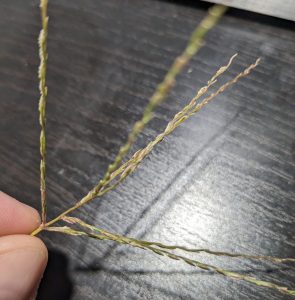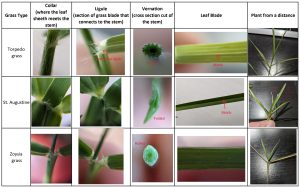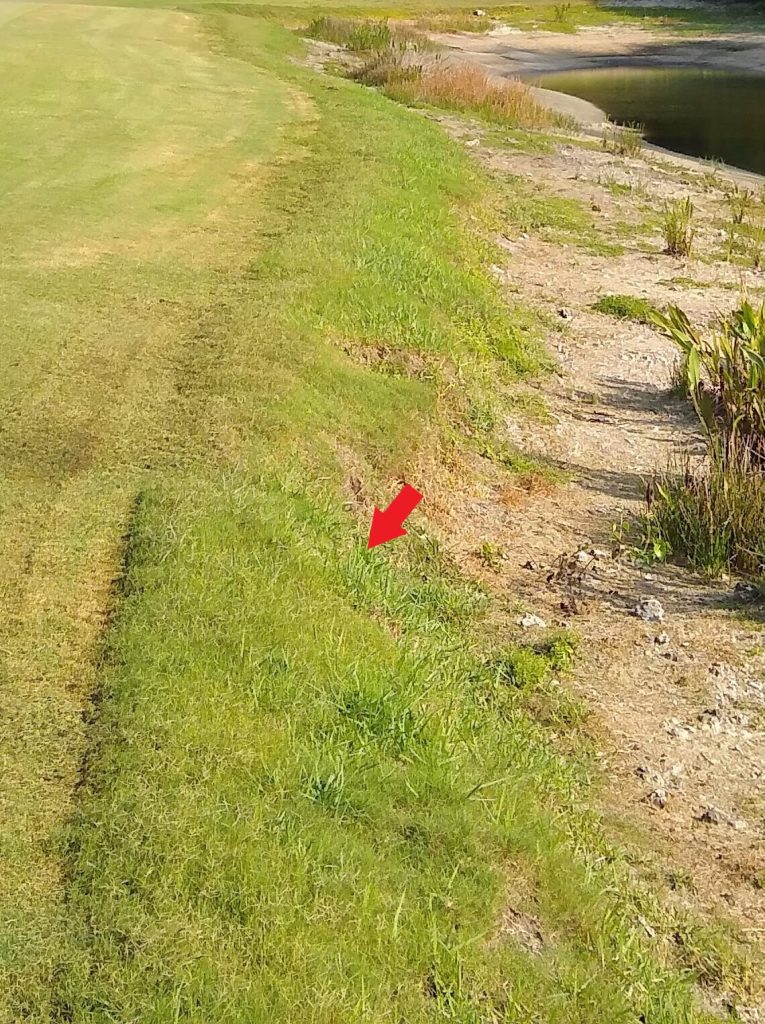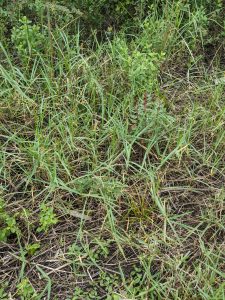What is Torpedograss?
Torpedo grass or Panicum repens is a warm-season, perennial turfgrass weed in Collier County that grows year-round. It is classified as a Category 1 invasive weed, which can alter the native plant community. Torpedograss grows well in full sun just like warm season grasses and can thrive in dry or wet soils. Torpedograss can grow up to 3 feet tall and aggressively spreads through rhizomes and stolons in the environment. The name torpedograss comes from the above ground roots (stolons), and below ground roots (rhizomes) being sharply pointed at the ends which can look like a “torpedo.” These rhizomes can grow up to a foot underground making it difficult to completely remove. If it has not been cut, the white seedheads may still be visible and flowing in the wind.

How can I tell it apart from my current grass?
Panicum repens can be identified by the silver-green color of the leaves with a prominent midrib, or center line on the leaf blade. The leaves can be flat or folded and the leaf tips come to a sharp point. The top of each of the leaves are generally sparsely hairy. The seedheads that are found on mature plants are small, flat, white, and typically not viable. Stems on torpedograss can have hair present throughout, but it can also be absent of hair on the younger portions of the plant. Torpedograss has folded vernation which means if you roll the stem between your fingers, you can feel two prominent edges to the stem. However, when you cut the stem in half, the stem may appear rounded with a hollow center. When looking at the “collar” or where the leaf meets the stalk, there are small hairs present. The “ligule” or inner portion of the leaf blade that meets the stem on torpedograss has a very small membrane with several hairs. All other warm season grasses except for bahiagrass do not have a membranous ligule. To see the membrane on the ligule easier, you will need to pull the leaf blade back from the stem and use a 10x hand lens to focus in on this area. Below are pictures of each warm season grass compared to torpedograss in relation to collar, ligule, vernation, leaf and the plant from a distance.


How did it get here?
Torpedograss spreads via vegetative propagation when rhizome or stolons are moved from one area to another. It may spread between yards through mechanical transportation with mowers if the blades are not cleaned in between cuttings. It may be transferred to a site that did not previously have the weed if the stolons are found in the soil or sod that is being installed on the site. Other times, it may creep from one yard or pond to another yard through its stolonous underground growth. Torpedograss is a hardy weed that will re-grow if only the above ground portion is pulled. It is a monocot in the Poaceae family, which is the same family as all turfgrass species available in south Florida, making it difficult to chemically control torpedograss without injuring the surrounding turfgrass.


What cultural and chemical treatments can be used?
The first option of control is to prevent the weed from becoming established. Clean all tools after use, especially ones that are used outside of a torpedograss free site. When adding soil or mulch, make sure they are coming from reputable vendors that can ensure they are weed free. However, once it has become established, chemical control is based on the turf type that is located on the site. Always read the herbicide label to see if the turfgrass on your site is listed as “tolerant.” Being tolerant of herbicides means that there maybe some visible damage after chemical application, but the turfgrass will continue to grow. Generally, st. augustine and bahiagrass are very susceptible to damage from herbicides that can target torpedograss. Zoysiagrass and bermudagrass tend to be more tolerant.
To treat torpedograss in bermudagrass and zoysiagrass, use of either quinclorac or trifloxysulfuron at the labeled rate can help eliminate torpedograss. As for st.augustine and bahiagrass lawns, no herbicides can control torpedograss without severely damaging the turfgrass. In the case of st. augustine and bahiagrass lawns, it may be best to kill patches of turfgrass mixed with torpedograss using applications of glyphosate or a grass selective herbicide such as fluazifop as necessary prior to re-sodding. Be sure to consult the label as to how long after an herbicide application you can re-sod.
As a precaution, always read and follow the label closely before applying any herbicides. Do not apply herbicides unless you have the proper training and calibrated equipment. Also when applying herbicides, it is good practice to trial them first in a small portion of the yard to check for any unwanted results.
If you need help identifying torpedograss, stop by at the UF/IFAS Collier County Extension or call us at: 239-252-7800.
All photos taken by Ryan Czaplewski.
Resources:
- Torpedograss biology: ENH1351/EP615: Biology and Management of Torpedograss (Panicum repens) in Ornamental Landscape Planting Beds (ufl.edu)
- Torpedograss chemical control: https://www.epls1.com/uploads/3/9/9/0/39907255/torpedograss_ufl.pdf#EP387.indd%3A%3A0
 7
7
